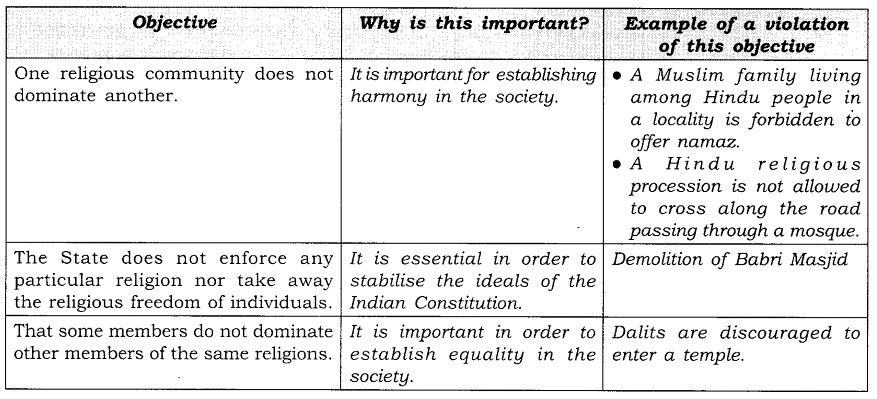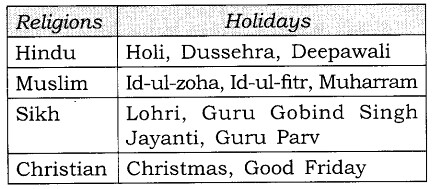Understanding Secularism
Q1. List the different types of religious practices that you find in your neighbourhood. This could be different forms of prayer, worship of different gods, sacred sites, different kinds of religious music and singing, etc. Does this indicate freedom of religious practice.
Answer:
Different types of religious practice:
(i) Islam.(Prayer)
(ii) Hinduism
(iii) Namaj
(iv) Sikhism
(v) Havan
Yes, this indicates freedom of religious practice.
Q2. Will the government intervene if some religious group says that their religion allows them to practice infanticide? Give reasons for your answer.
Answer:
The government will surely intervene if some religious group says that their religion allows them to practice infanticide. Needless to say that the practice of infanticide is a crime. Under this practice the life of a newly-born child is killed. The law does not allow anyone to kill a life.
Q3. Complete the following table:
Answer:

Q4. Look up the annual calendar of the holidays of your school. How many of them pertain to different’religions? What does this indicate.
Answer:
Holidays in a school calendar for different religions:

Q5. Find out some examples of different views within the same religion.
Answer:
Different views are followed even within the same religion. As for example, only in the Hindu religion, we have hundreds of deities worshipped by different groups of people. Similarly, in the Muslim community, there are Shiyas and Shunnis. In Jainas, there are Shwetambar and Digambar sects. In Buddha Dharma, there are Hinayaans and Mahayaans.
Q6. The Indian State both keeps away from religion as well as intervenes in religion. This idea can be quite confusing. Discuss this once again in class using examples from the chapter as well as those that you might have come up with.
Answer:
India is a land of complex ideas. It is difficult to understand what it really wants. There are many ideals in the Constitution but practices are quite different from them. In many cases we see laws explain a concept in a different way. But people interpret it differently. Law itself in some cases acts differently. As for example, in secular state law has nothing to say in any of the practices of the religion but when the dominance of upper castes in religion was brought to question the law took favour of the lower castes. This interference of the State creates confusion.
Q7. This poster highlights the need for ‘Peace’. It says, “Peace is a never-ending process….. It cannot ignore our differences or overlook our common interests.” Write in your own words what you think the above sentences are trying to convey? How does it relate to the need for religious tolerance.
Answer:
a).Peace is a never-ending process. It is the need of today.
b).Peace respects our common interest and removes or minimize our difference.
c). Peace helps us to live together in harmony.
Multiple Choice Questions
Choose the correct option:
(i) Which one is a correct statement with regard to Saudi Arabia.
(a) Non-Muslims can gather in a public place for prayer.
(b) They cannot build a temple, church, etc.
(c) They can live in their own way.
(d) None of the above.
(ii) The most important aspect of secularism is its …………
(a) separation of religion from State power.
(b) separation of politics from religion.
(c) separation of one community from another
(d) mixing of religion with State power.
(iii) The government cannot force Sikhs to wear a helmet while driving two-wheelers because ……
(a) Sikhs are very powerful.
(b) they do not obey government rules.
(c) they look handsome in pagri.
(d) wearing a pagri is a very important part of Sikh religion.
(iv) In American secularism, there is a ……
(a) the strict separation between religion and the State.
(b) the loose separation between religion and the State.
(c) the strict mingling of religion with the State.
(d) the strict rule that contracts all religions.
Fill in the Blanks.
1. The intervention of the State can also be in the form of Support
2. In the United States of America, most children in government schools have to begin their school day reciting the
3. ‘Pledge of Allegiance
4. The most important aspect of secularism is its separation of religion from state power.
5. Government schools don’t celebrate any religious festivals on the school premises.
6. The Indian State is not ruled by a religious group and nor does it religious, support any one religion.
True/False
a. In Indian secularism, the State is not strictly separate from religion. ( True )
b. Wearing a pagri is central to a Sikh’s religious practice.( True )
c. Government schools can promote any one religion. (False)
d. The Indian Constitution does not grant religious communities to set up their own schools and colleges. (False)
e. In Indian secularism, the State cannot intervene in religion.(False).
